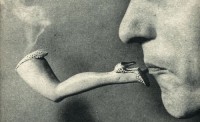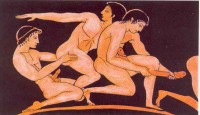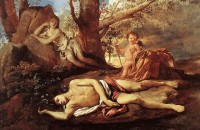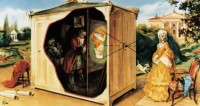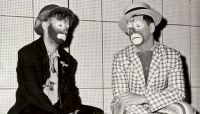Evan Malater & Cecilia Wu: Pass the Porcupine – Freud, Porcupines and You
dear Porcupines, As an extra credit assignment following the Angelo Villa talk, Cecilia Wu and I became interested in the porcupine parable from Schopenhaeur that Angelo Villa offered towards the end of his presentation. Angelo used the parable to address the question of how a group might survive its narcissistic and hysteric tendencies, its craving for leadership and its hatred of leaders, its belief in democracy in the face of the reality of inequality and its tendency to propagate itself on fumes of unanalyzed transference to mischievous effect. We became curious about the porcupine parable. A random google using keywords “Freud porcupine” revealed a whole teeming history of Freud andporcupines that amazed us and led us to weeks of porcupine research that we now share with...Read More
Esther Sperber: The Architecture of Psychotherapy – New York Times Couch
“If you listen to psychotherapists when they talk to one another, you will often hear them speak of something called the “therapeutic frame.” This term, coined by the psychoanalyst Marion Milner, refers to the set of conventions and ground rules that structure the therapeutic experience. Just as the frame of a painting defines the borders of a work of art, the therapeutic frame is the “container” in which the therapy takes place. Architecture is a meditation on entering and exiting.” Click here to read more
Vanessa Sinclair: Das Unbehagen of Duchamp, Dada and Psychoanalysis
“In 1917, Marcel Duchamp submitted a urinal to the first annual exhibition of the Society of Independent Artists here in New York under the pseudonym, R. Mutt. Duchamp was one of the founding members of this organization, along with Walter Arensberg, Katherine Dreier, Man Ray, and Joseph Stella. This society was founded with the intention of providing a platform for individual artists to showcase their work, whether new, experienced, experimental, or avant-garde, and was dedicated to advancing the ideas of independent artists, free of juries, prizes, or ranking of any kind. As long as one paid the entry fee of six dollars, one’s work would be shown. The first annual exhibition included over 2,000 works of art. The catalog was organized and the exhibition hung in alphabetical order by...Read More
Angelo Villa: Hystericization and Psychoanalytic Belonging
“For belonging does entail an identification; I suggest that the turning point must be made through the difference between a passive identification and an active one. As far as the analysis delves into a familial bond, it allows the patient to return and find a new place in his personal history; a different place from where he had been placed by his symptom, along with those symptoms belonging to others. In other words, the analysis doesn’t break the belonging (how would it be possible?) but it allows the patient to introduce into it his own subjectivity, to have the chance to finally re-write his belonging. This is what needs to happen in an association, too. Belonging to an association should entail the possibility of affecting the life of the association. This is the only way towa...Read More
Patricia Gherovici: Attack of the Difficult Ecrits – Class 2 – The Situation of Psychoanalysis
This class was based on a collaborative annotated reading by Patricia Gherovici and Manya Steinkoler of Lacan’s “The Situation of Psychoanalysis and the Training of Psychoanalysts in 1956,” to be published in the forthcoming Reading the Écrits – A Guide to Lacan’s Works, edited by Derek Hook, Calum Neill, and Stijn Vanheule. The following is an excerpt from this forthcoming volume, posted here with permission from the editors: Psychoanalytic Fable In the essay, fittingly vituperative, Lacan will now adopt an absurdist tone in what will take the form of an extended fable emulating moralist philosopher Jean de la Bruyere (1645-1696)’s satires inspired by Theophrastus (371-287 BC). Both authors are dear to Lacan, and the French comic tradition. Lacan describes the pitfalls of the bureau...Read More
Jamieson Webster: Attack of the Difficult Ecrits – Class I – Variations on the Standard Treatment
A poetic rendition by Cecilia Wu If we follow Jamieson’s lead and focus on the writing itself, considering the fact that Lacan’s writings are unsweetened, condensed transcripts of his speech acts, it’s hard to dismiss his mode of attack as a pain in the ass, or as unruly hunks of raw hide to be adorned with the transferential ornaments of infantile hate. Lacan himself counsels against merely reproducing the crossfire of attack and counterattack, serially recapitulating a civil war of transference that exiles the enemy while clinging to the hope that it will all come out in the wash. The clash of minor differences runs through an opinionator equalizer akin to the trifling ‘intermediary discourse’ Lacan wishes to silence, the chatter that enforces homeostasis as...Read More
Gerard Pommier: What Did Feminism and Gender Studies Bring to Psychoanalysis?
In his presentation to Das Unbehagen, Gerard Pommier addressed the challenge of defining the term ‘Woman’: “The uncertainty is such that this difficulty of definition could be used itself as a definition and normative ideal! Judith Butler writes, for instance, that “if a subject unique to feminism remains to be constructed, it would be even more realistic to abandon such a project,” since, she explains, “the category ‘women’ can only reach some stability and coherence within the heterosexual matrix…” Nothing shows this difficulty better than the fragmentation of the feminist movement, or the opposition to feminism by a large number of women. Some theoreticians maintain that gender is a relationship, and not an individual attribute. Others, like Simone de Beauvoir, attest ...Read More
Somatic Experiments, Clinical Encounters: In the Consulting Room with “Testo Junkie” – Paul B. Preciado in conversation with Kirsten Lentz, Carolyn Stack and Jamieson Webster
This interdisciplinary forum on Testo Junkie: Sex, Drugs, and Biopolitics in the Pharmacopornographic Era, puts author Paul B. Preciado into conversation with clinicians — Kirsten Lentz, Carolyn Stack, and Jamieson Webster, along with moderator Muriel Dimen — to discuss the range of ways Preciado’s genre-bending account of gendered embodiment both challenges and expands psychoanalytic accounts of gender, desire, and somatic experience. And vice versa. This forum continues a multi-year joint initiative between CSGS and the journal Studies in Gender and Sexuality to promote open-ended exchanges between cultural theory and psychoanalytic theory. Co-sponsored by the NYU Center for the Study of Gender & Sexuality, the NYU Department of Performance Studies, and Studies in Gender and Sexual...Read More
Sergio Benvenuto: Perversions are not Paraphilias
“Many deny, of course, that perversions exist, even if the dominant psychiatry has re-baptized them as “paraphilias.” A name change attributable to political correctness, considering that the term “pervert” is today an insult. In Greek, paraphilia means “wrong love”. After all, it’s better to insult a pervert in Ancient Greek than in Modern English. Some note that we call perverse those sexual acts we don’t consider “normal.” But the criteria for sexual normality has varied from one era to another, and today even more quickly. And then, the picture is complicated by the fact that many perversions—such as masochism, urophilia or fetishism—have no criminal implications, while others lead to very serious incriminations. So we cannot reduce perversions to simply illegal sexual activities...Read More
Adele Tutter: Under the Mirror of the Sleeping Water – Poussin’s Narcissus
Nicholas Poussin’s four paintings on the theme of Narcissus and Echo, completed over the course of three decades, reflect a deepening appreciation of their source in Ovid’s Metamorphoses. Poussin’s interpretations of the Narcissus myth parallel critical junctures in the development of psychoanalytic theories of narcissism, including those of Freud, Andreas-Salome, and Rosenfeld. The analysis of Poussin’s evolving vision supports a radical reappraisal of the enigmatic myth at the heart of psychoanalytic theory and practices, and the disturbances named after it. Click here to listen to audio Click here to read Adele Tutter’s “Under the mirror of the sleeping water: Poussin’s Narcissus” published in the International Journal of Psychoanalysis, 2014 Cecilia Wu’s C...Read More
Elissa Marder: Knock Knock: Femininity, Fixation, Photography
“Ultimately, what I am seeking in the photograph taken of me (the ‘intention’ according to which I look at it) is Death: Death is the eidos of that Photograph. Hence, strangely, the only thing that I tolerate, that I like, that is familiar to me, when I am photographed, is the sound of the camera. For me, the Photographer’s organ is not his eye (which terrifies me) but his finger: what is linked to the trigger of the lens, to the metallic shifting of the plates (when the camera still has such things). I love these mechanical sounds in an almost voluptuous way, as if, in the Photograph, they were the very thing -and the only thing -to which my desire clings, their abrupt click breaking through the mortiferous layer of the Pose. For me the noise of Time is not sad: I love bells, clocks...Read More
Performance/Panel: “The Ontology of the Rape Joke” with Vanessa Place, Jeff Dolven, Gayle Salamon, and Jamieson Webster
Rape is an act of physical and sexual violence; jokes are understood as a kind of psychic disruption, with humor forcing a release of pleasure. According to Freud, jokes can function as a shared victory over social repression, and “jokes that have a purpose run the risk of meeting with people who do not want to listen to them.” What is the purpose of the rape joke? Do we want to listen? And given that the ear is an orifice we cannot close, is it ever possible to consent to humor? Click here for audio courtesy of host Cabinet Magazine ABOUT THE PARTICIPANTS Jeff Dolven teaches poetry and poetics, especially of the English Renaissance, at Princeton University. A book of his poems, Speculative Music(Sarabande Books), came out in 2013. A new book of criticism, The Sense of Style, is forthcomin...Read More




